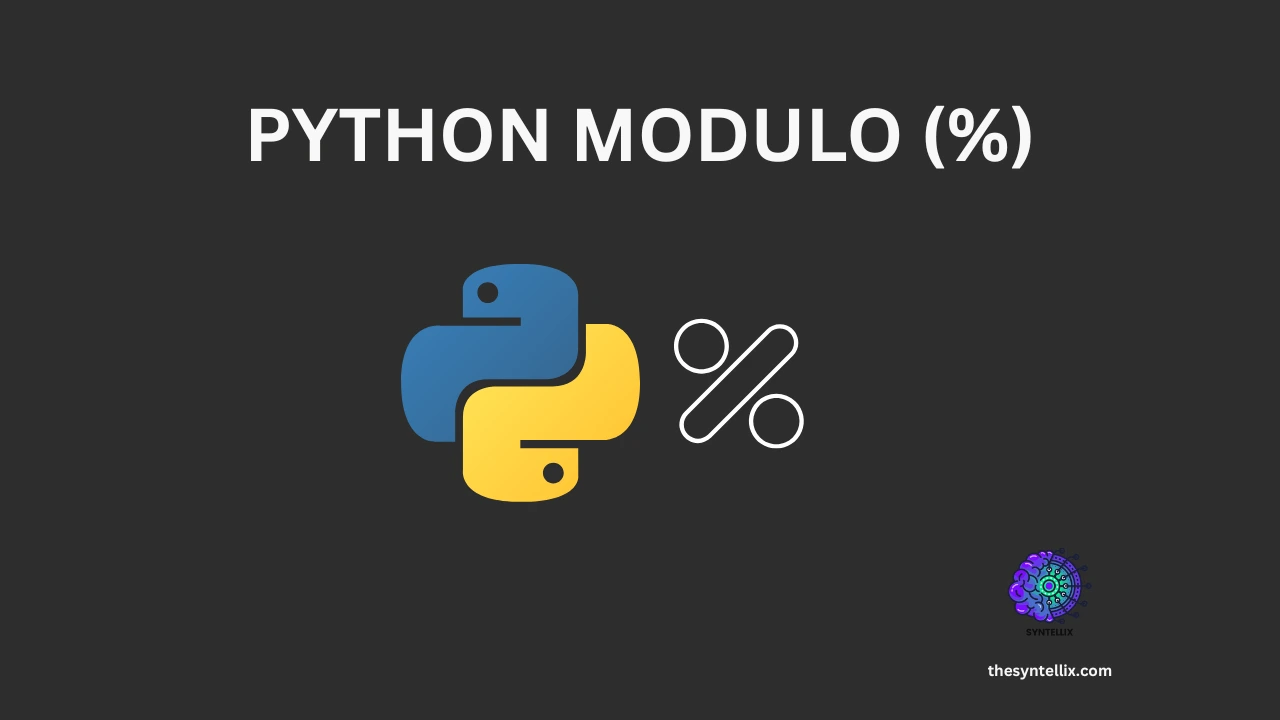What Is the Python Modulo Operator?
The Python modulo operator (%) is a fundamental arithmetic operator used to calculate the remainder of a division between two numbers.
When you write a % b, Python divides a by b and returns the remainder of that division. For example, 10 % 3 evaluates to 1, because 10 divided by 3 is 3 with a remainder of 1.
This operator plays a crucial role in programming tasks where divisibility or cyclical behavior is involved, such as determining if a number is even or odd, cycling through list indices, implementing periodic actions in loops, or managing time and date calculations.
What makes Python’s modulo behavior unique is its handling of negative numbers—the result of a % b always takes the sign of the divisor (b), ensuring consistency with Python’s mathematical conventions.
Although often introduced as a basic math concept, the modulo operator is widely used in real-world applications like gaming logic, scheduling systems, hashing algorithms, and UI development, making it a small but powerful tool in every Python developer’s toolkit.
Think of it this way:
7 % 3 # Output: 1
Here, 7 divided by 3 is 2 with a remainder of 1, so the output is 1. That’s the modulo result.
Python Modulo overview
While it may seem like just a basic math trick, the modulo operator is a core building block in many programming patterns, including:
Cycling through items in a loop
Checking divisibility
Building logic for games and calendars
Hashing and cryptography
Implementing circular queues or buffers
Syntax and Examples
The syntax is simple:
a % b
This returns the remainder when a is divided by b.
Real World Use cases of Python Modulo
1. Cycling Through Items in a List (Circular Indexing)
In many applications (e.g. games, UIs, round-robin scheduling), we need to loop through a list repeatedly. Modulo is perfect for that.
Use Case: Carousel or Slider
images = ["img1.jpg", "img2.jpg", "img3.jpg"]
for i in range(10): # simulate 10 "next" clicks
current = images[i % len(images)]
print(f"Displaying: {current}")
It prevents index errors and lets you “wrap around” the list without writing extra logic.
2. Even/Odd Checks (Divisibility Logic)
The modulo operator is often used to test if numbers are divisible — a critical part of filtering, formatting, and logic-based branching.
Use Case: Highlight Even Rows in a Table
data = ["Row1", "Row2", "Row3", "Row4"]
for i, row in enumerate(data):
style = "even-row" if i % 2 == 0 else "odd-row"
print(f"{row} → Style: {style}")
This is used in web apps and spreadsheets for styling alternate rows.
3. Scheduling Periodic Events
When you want something to happen every N steps/iterations/time units, modulo helps you trigger logic cleanly.
Use Case: Log Progress Every 100 Iterations
for i in range(1, 1001):
if i % 100 == 0:
print(f"Checkpoint at iteration {i}")
Used in training AI models, batch processing, or large-scale data scripts.
4. Timestamps and Time-Based Logic
In time-based applications (e.g. clocks, timers, schedules), modulo helps convert seconds into minutes, hours, or handle overflow.
Use Case: Digital Clock Formatting
total_seconds = 3672
hours = (total_seconds // 3600) % 24
minutes = (total_seconds % 3600) // 60
seconds = total_seconds % 60
print(f"{hours:02d}:{minutes:02d}:{seconds:02d}")
# Output: 01:01:12
Summary Table
| Use Case | Real-World Scenario |
|---|---|
| Circular indexing | Image sliders, rotating ads, round-robin |
| Even/odd checks | UI row styling, game logic |
| Periodic event triggers | Logging, autosave, monitoring |
| Time/timestamp formatting | Clocks, timers, scheduling tools |
As someone who writes Python professionally, I use the modulo operator in automated test scheduling, circular array problems, and even for rate-limiting operations in async tasks.
When working on algorithms, I often use modulo to “wrap around” array indexes—especially in circular queue implementations.
Always comment your % usage in production code. Future maintainers might not instantly understand your modulo logic, especially if it’s used in a non-obvious way.
All examples in this post have been tested in Python 3.11. You can run them using any standard Python interpreter (IDLE, VS Code, Jupyter Notebook, etc.). For deep technical insight, refer to the Python official documentation on expressions.
Conclusion
The modulo operator in Python may be small, but it’s incredibly powerful when you understand how to use it correctly. Whether you’re a beginner trying to get your hands dirty or an experienced coder optimizing performance, % can help you write cleaner and more efficient code.

Stay ahead of the curve with the latest insights, tips, and trends in AI, technology, and innovation.

